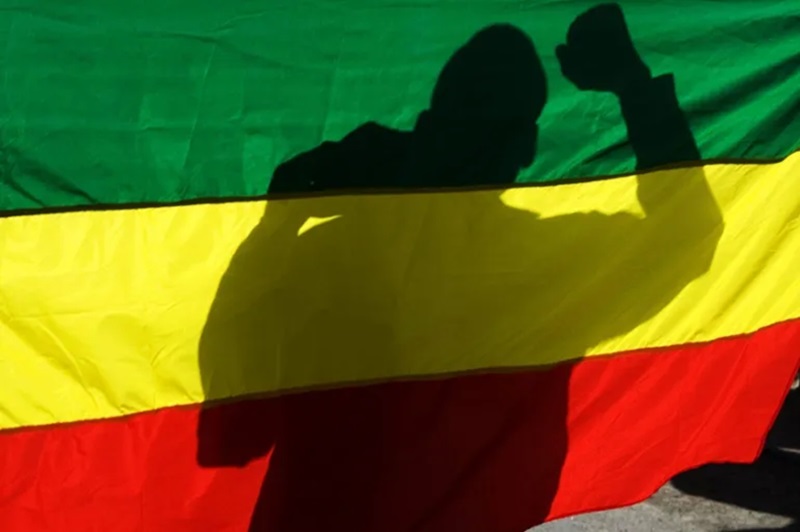First Published On – CULTURE & SOCIETY

In the early part of the 4th century, two Christian children of Syrian origin, returning from India on a Roman ship, disembarked at an Aksumite port on the Red Sea. These young Christians, the younger Edesius and the elder Frumentius, were brothers or close relatives. As they traveled back with their uncle, Meropius, their ship was pillaged by the native Ethiopians. The pillagers, however, spared the lives of the two youths, and they were subsequently taken to the Royal court. The king appointed Frumentius guardian of the Treasury and Edesius as his cupbearer. Eventually, the monarch died, leaving behind two young sons and the hopes of the kingly crown.
The two young Syrians, despite the diligence and care with which they exercised their duties at the court, longed to return to Syria—more precisely, to their native city of Tyre. The widow queen did her best to detain them in Aksum at least until one of the young princes would be prepared to take up the reins of government. During the reign of the queen, Frumentius accepted the responsibility of educating the two princely brothers, Ezana and Saizana (in Greek form, Abraha and Atzbaha in Ge’ez).
Ezana would become king of Ethiopia—then called Aksum (or Axum)—and establish the first centralised Christian empire.[i]
Armenia, according to the hagiographical account of the monk Agathangelos, is considered to be the first Christian nation when in the year 301 A.D. the Armenian King Trdat III was baptized by St. Gregory the Illuminator, a good generation before Ezana. Yet, if one is to accept legend as history in that Armenia was the first nation to officially accept Christianity, then Ethiopia, based on what is written on the 8th chapter in the Acts of the Apostles, has a better claim to that title.

Acts states that an Ethiopian eunuch, who was the finance minister of Candace, Queen of Aksum, was baptized by Philip the Deacon and was instructed in the teachings of Christ. (Acts 8, 26-39) The eunuch then took it upon himself to evangelize the Christian faith in his own land. There is also, as written in the Golden Legend by Jacopus de Voragine that the Apostle Matthew evangelized and thus institutionalized the Christian faith in Ethiopia:
‘The Apostle St. Matthew evangelized Ethiopia, where he disclosed as agents of the Devil, Zaroes and Arphaxat, who, as magicians, enchanted the king and the people, while at the same time misleading them. Then, Matthew the apostle entered into that city and was lodged with the eunuch of Candace, the queen, whom Philip baptised.’
All things being equal, unlike in Armenia, there is archeological proof in Ethiopia of Christianity becoming the official religion. After his conversion, Ezana recognized the polemical situation facing Christianity, and did not want to offend the majority of his subjects who still maintained their pagan beliefs. ‘His adoption of Christianity was accompanied by a weakening in his personal claim of divine status.’[ii] According to the historian Steven Kaplan, Ezana wanted to project himself as a Christian and as an ally to the small group of Christians who exercised influence in trade and commerce.
‘He was thus forced to steer a middle path between proponents of the new religion [his own] and traditionalists. [When he said, ‘I believe in Your Son…’] written at the same time, the king attempts to present himself in a manner acceptable to his pagan subjects. In this text, he refers to God as the ‘Lord of Heaven,’ a designation which would certainly be understood by the bulk of the population as a reference to a pagan deity.[iii]
The are also coins that reveal that Ezana ‘adopted Christianity during the course of his reign, since earlier ones show him as a worshipper of the traditional gods, of whom Ares, presumably an indigenous deity identified with the Greek god, is perhaps one. However, coins of this king’s reign carry the cross, and there can be little doubt by about 350 A.D.— thirty years before Rome officially made Christianity its official religion in 380 A.D.—and it is from this time that there began the close connection between Christianity and what was to become the Ethiopian nation.[iv]

‘In the faith of God and the power of the Father, and the Son and the Holy Spirit who have saved my kingdom. I believe in Your Son, Jesus Christ who has helped me who will help me always. I Aezanas (sic) king of Axum…’[vii]
Ezana’s conversion was the climax of an influx from the ever-changing Mediterranean world in Late Antiquity. However, it was only those who were related to such an impact, i.e., the higher classes, as already indicated, who were exposed to Christian influence. The congregation of St. Frumentius probably consisted of only a section of the royal house, along with foreign merchants and their households. This was because his clergy was mainly of foreign provenance, and Greek was the language of the Church. This not only limited the scope of Christianity’s expansion during that period; it also led to the rise of conservative anti-Christian forces with which the early Christian kings had to contend.[viii] Nevertheless, Ethiopia can claim that it was the first nation to accept Christianity, which lasted until the deposition of the last Ethiopian Emperor Hailé Sellassié (Power of the Trinity) in 1974.
[i] Teodoros Kiros, Zara Yacob – Rationality of the Human Heart. Trenton, Red Sea Press, Inc., 2005, p. 32.
[ii] David W. Phillipson, Foundations of an African Civilisation: Aksum and the northern Horn, 1000 BC – AD 1300. London, Addis Ababa University Press, 88.
[iii] Steven Kaplan, The Monastic Holy Man and the Christianization of Early Solomonic Ethiopia. Wiesbaden, Coronet Books, Inc., 1984, 16.
[iv] P. L. Shinnie, “The Nilothic Sudan and Ethiopia — 600 B.C. to A.D. 600”, The Cambridge History of Africa, Vol. 2. Cambridge, Cambridge University Press, 265.
[v] Paul Henze, Layers of Time. New York, Hurst & Company, 2000, 30-31.
[vi] John D. Carlson, “Externality and Incorporation in the World System: Abyssinia – Anamolyor Palimpsest?”, American Sociological Review, Vol. 18. Washington, D.C., SAGE Publications, 2001 , 171.
[vii] Kevin O’Mahoney, The Spirit and the Bride. United Printers, Addis Ababa, 1994, 144-145.
[viii] Tadesse Tamrat, Church and State in Ethiopia: 1250-1527. Oxford, Oxford University Press, 1972, 23.
Mario Alexis Portella is Archdiocesan Chancellor of Florence and a Minor Canon of the Cathedral of Santa Maria del Fiore and Adjunct Professor of Canon Law at St. Phillip Neri Seminary in Gricigliano, Italy. He has a doctorate in canon law and civil law from the Pontifical Lateran University in Rome; he also holds an MA in Medieval History from Fordham University, as well as a BA in Government & Politics from St. John’s University. He is author of ‘Islam: Religion of Peace?: The Violation of Natural Rights and Western Cover Up’ and ‘Ethiopian and Eritrean Monasticism: The Spiritual and Cultural Heritage of Two Nations’.




















